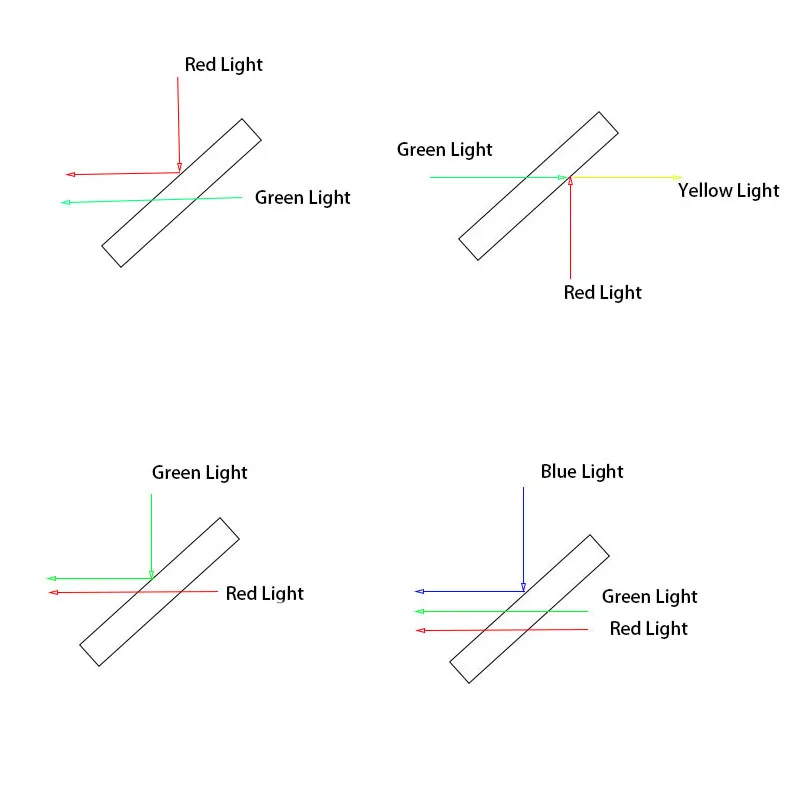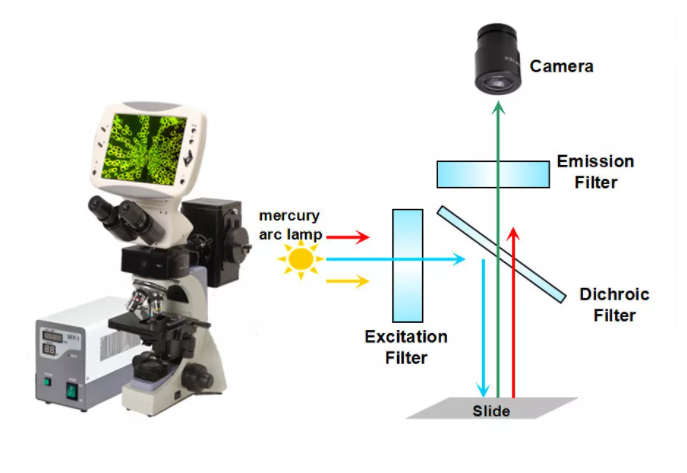Dichroic mirrors and beam splitters are important optical components in the field of optics, but they have different uses and exhibit different optical properties.
This article will explore their differences in functionality and applications and shed light on their uniqueness.
What is a Dichroic Mirror?
A dichroic mirror, also known as a dual-band mirror, dual-wavelength mirror, or dichroic reflector, and sometimes referred to as a dichroic version of a cold mirror, is typically used behind a light source to reflect visible light while allowing invisible infrared light to pass through.
These mirrors can be used to separate light by wavelength and play a significant role in many optical devices.
Types of Dichroic Mirrors
The Angle of Incidence (AOI) for dichroic mirrors is typically 45 degrees. Dichroic mirrors are categorized into short-pass, long-pass, and multi-band dichroic mirrors.
Long-pass Dichroic Mirrors: A long-pass mirror has high reflectance at short wavelengths and high transmittance at longer wavelengths.
Short-pass Dichroic Mirrors: A short-pass mirror has a high transmittance at short wavelengths and high reflectance at longer wavelengths.
Multi-band Dichroic Mirrors: Multi-band dichroic mirrors are a special type of optical component capable of simultaneously reflecting and transmitting light within different wavelength ranges.
Here is a spectrum of long-pass dichroic mirrors:

What is a Beamsplitter?
A beamsplitter is an optical device that splits an incident light beam into two or more beams by reflecting a portion of the light while transmitting the remaining portion.
Beamsplitters are commonly used in various optical systems and instruments for tasks such as directing light along different paths, combining light from multiple sources, or separating light into different wavelengths.
Types of Beamsplitter
Reflective Beamsplitters: Reflect a specific wavelength range while allowing another wavelength range to pass through.
Transmissive Beamsplitters: Transmit a specific wavelength range while reflecting another.
Each type serves distinct purposes and finds applications in various fields such as biomedical imaging, laser systems, and optical laboratories.
Selecting the appropriate beamsplitter depends on the specific requirements of the optical system and desired optical performance.
Here is a spectrum of 50/50 beamsplitter:

Dichroic Mirrors Vs Beamsplitters: Production process
1. Dichroic Mirrors
The manufacturing of dichroic mirrors, a key expertise of dichroic glass manufacturers, primarily involves the deposition of multiple layers of dielectric materials on a transparent substrate, like glass.
This process, commonly referred to as thin-film deposition, can be achieved through several techniques including physical vapor deposition (PVD), chemical vapor deposition (CVD), or sputtering.
By precisely controlling the thickness and material composition of each layer, a filter that works based on the interference effects of light waves is constructed, thereby enabling the selective reflection and transmission of specific wavelengths of light.
Optolong utilizes hard dielectric coating technology to enhance the durability of its dichroic mirrors. They employ advanced manufacturing techniques to produce high-quality dichroic mirrors customized for specific applications.
These dichroic mirrors not only boast high transmission efficiency and color fidelity but also demonstrate excellent environmental stability, meeting the needs of various application settings.
It is important to note that the reflective and transmissive properties of dichroic mirrors depend to some extent on the angle of incidence (AOI) of light. Our dichroic mirrors typically have an AOI of 45 degrees, a design aimed at optimizing the optical performance of the mirrors.
Click to learn: Dichroic mirror: What is it? Advantages and applications
2. Beamsplitters
Beamsplitters are usually made of optical glass or similar transparent materials and coated with special optical coatings. These materials and coatings are carefully engineered to achieve the desired optical properties of a beamsplitter, such as splitting incident light into two or more beams, and typically have high transmittance and/or high reflectivity.
Optical coatings are a vital part of the production of beamsplitters, as they determine the optical properties of the beamsplitter. These coatings are typically applied to the substrate surface using techniques such as physical vapor deposition (PVD) or chemical vapor deposition (CVD).
The design of the coating needs to consider the specific application of the spectroscope, such as wavelength range, optical absorbance, splitting ratio and other factors.
Optical coatings are typically constructed from multiple layers of dielectric materials, with precise control of layer thickness and refractive index to achieve the desired optical properties.
In addition to optical coatings, the fabrication of spectroscopes also involves other process steps, such as substrate selection and preparation, optimization and testing of coatings, quality control, etc.
Making a spectroscope requires highly specialized equipment and technology, and is usually completed by specialized optical manufacturers or research institutions.
To accommodate a broader range of application requirements, Optolong also offers customization services, allowing customers to select different mirror specifications and styles based on their project needs. Click here to contact us!
Dichroic Mirrors Vs Beamsplitters: Applications
1. Dichroic Mirrors
Dichroic mirrors, also known as dichroic filters, play a pivotal role in a wide range of optical applications due to their unique ability to selectively transmit and reflect different wavelengths of light—a fundamental dichroic mirror function.
Below are detailed applications illustrating the versatility and importance of dichroic mirror function in various technologies:
Fluorescence Microscopy: In the realm of scientific research, particularly in the field of biology and medicine, dichroic mirrors are integral components of fluorescence microscopes.
They act as beam splitters that efficiently direct illumination of a specific excitation frequency towards the sample.
Following excitation, these mirrors are designed to pass the emission frequency, which is typically of a longer wavelength than the excitation light.
This allows for the capture of detailed fluorescent images of specimens, enabling researchers to observe cellular structures, proteins, and other biological markers with high specificity and sensitivity.
LCD Projectors: In the world of digital imaging and presentation, dichroic mirrors find application in some LCD projectors.
These filters are utilized to split the white light emitted from the lamp into its primary components—red, green, and blue—before it is passed through the individual LCD units.

This separation process enhances the color purity and brightness of the projected image, leading to a more vivid and engaging viewing experience.
Unlike traditional prism-based systems, dichroic filters offer a more efficient and precise method for color separation, contributing to the overall performance and compactness of the projector.
Dichroic filters/dichroic mirrors, excitation filters, and emission filters form the fluorescence filter set used in fluorescence microscopy.

2. Beamsplitters
Spectroscopy: Spectroscopes are used in spectrometers to separate incident light into different wavelength ranges to facilitate accurate spectral analysis of samples.
Biomedical imaging: Spectroscopes are commonly used in fluorescence microscopy and other imaging techniques to separate excitation and emission wavelengths, allowing for selective illumination and accurate capture of fluorescence signals.
Laser system: A beam splitter is an important component in a laser system that is used to combine or separate light beams of different wavelengths. They find applications in laser beam steering, fiber coupling, and wavelength multiplexing.
Optical Coherence Tomography (OCT): OCT imaging systems use beam splitters to split light into a reference arm and a sample arm, enabling high-resolution imaging of biological tissues and materials.
What are the required specifications for dichroic mirrors and beam splitters?
Dichroic mirrors and beamsplitters are optical components with different specifications for specific applications. Their specifications typically include the following:
Reflection wavelength range: This specification refers to the wavelength range of light reflected by a dichroic mirror or beam splitter. It represents the wavelength of light that a mirror or beam splitter effectively reflects rather than transmits.
Transmission wavelength range: This specification indicates the wavelength range of light transmitted by a dichroic mirror or beam splitter. It specifies the wavelengths that a mirror or beam splitter allows light to pass through instead of reflecting.
Edge wavelength: Edge wavelength is the wavelength outside the specified reflectance and transmittance range.
These wavelengths may reduce reflectance or transmittance and may appear at the edges or boundaries of the device’s spectral response.
What are the characteristics of Optolong’s dichroic mirrors and beamsplitters?
Optolong’s dichroic mirrors and beam splitters possess several key characteristics that make them suitable for various optical applications, their characteristics are as follows:
IAD Hard Coating: Utilizes Ion-Assisted Deposition technology for durable coatings.
Wavelength Range: Covers from UV Dichroic filters to infrared, accommodating diverse applications.
High Reflectance: Ensures optimal reflection of unwanted wavelengths.
High Transmittance: Guarantees excellent transmission of selected wavelengths.
Surface Quality: Offered in standards of 40/20 and 60/40, ensuring clear and defect-minimal optics.
Glass Substrates: Made with high-precision polished glass for superior optical quality.
Conclusion
In optical experiments and system design, the correct selection of dichroic mirrors or beam splitters is crucial to achieving optical functions.
The Optolong website offers a variety of dichroic mirror and beam splitter options, whether you need beam splitting or wavelength separation, you can find a solution to suit your needs here, we are always committed to providing expertise to their customers and custom filters to advance the field of optics and contribute to the future of optics.

